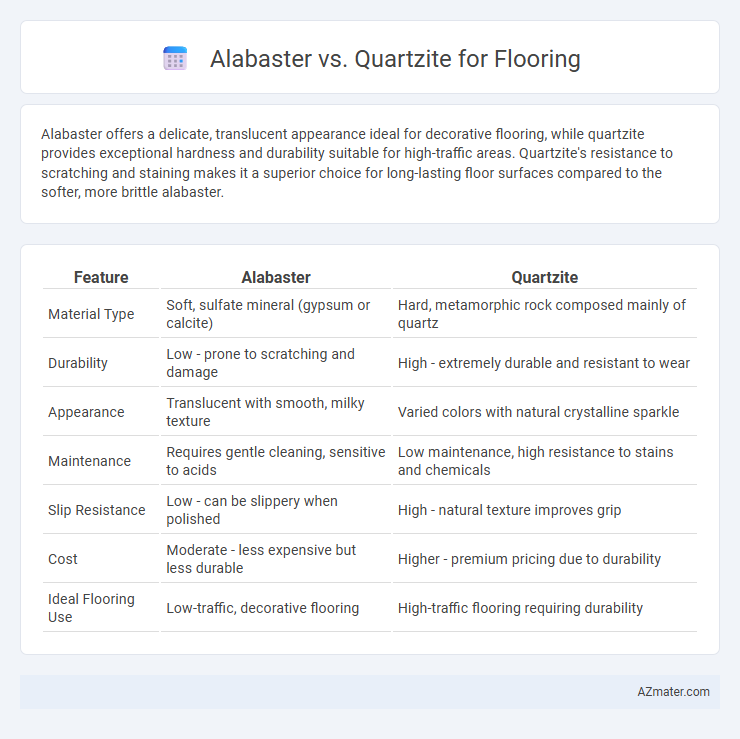Alabaster offers a delicate, translucent appearance ideal for decorative flooring, while quartzite provides exceptional hardness and durability suitable for high-traffic areas. Quartzite's resistance to scratching and staining makes it a superior choice for long-lasting floor surfaces compared to the softer, more brittle alabaster.
Table of Comparison
| Feature | Alabaster | Quartzite |
|---|---|---|
| Material Type | Soft, sulfate mineral (gypsum or calcite) | Hard, metamorphic rock composed mainly of quartz |
| Durability | Low - prone to scratching and damage | High - extremely durable and resistant to wear |
| Appearance | Translucent with smooth, milky texture | Varied colors with natural crystalline sparkle |
| Maintenance | Requires gentle cleaning, sensitive to acids | Low maintenance, high resistance to stains and chemicals |
| Slip Resistance | Low - can be slippery when polished | High - natural texture improves grip |
| Cost | Moderate - less expensive but less durable | Higher - premium pricing due to durability |
| Ideal Flooring Use | Low-traffic, decorative flooring | High-traffic flooring requiring durability |
Introduction to Alabaster and Quartzite Flooring
Alabaster flooring offers a smooth, translucent surface known for its soft, warm appearance and is often chosen for its elegant aesthetic in interior design. Quartzite flooring, a natural metamorphic rock, provides exceptional durability and resistance to wear, making it ideal for high-traffic areas. Both materials bring unique textures and colors, with alabaster highlighting subtle translucency and quartzite showcasing a robust, granular structure.
Material Composition and Formation
Alabaster is a soft, fine-grained form of gypsum or calcite, primarily composed of calcium sulfate or calcium carbonate, formed through the evaporation of mineral-rich waters in sedimentary environments. Quartzite is a hard, metamorphic rock formed from quartz-rich sandstone subjected to intense heat and pressure, resulting in a dense and durable material rich in silicon dioxide. The distinct mineral compositions and formation processes of alabaster and quartzite directly influence their hardness, durability, and suitability for flooring applications.
Appearance and Aesthetic Appeal
Alabaster flooring offers a soft, translucent appearance with subtle veining and a smooth texture, creating an elegant and luminous ambiance ideal for refined interior designs. Quartzite boasts a more varied and complex aesthetic, featuring natural patterns, mineral flecks, and a durable, glassy finish that adds both sophistication and a dynamic visual interest to high-traffic areas. The choice between alabaster and quartzite for flooring ultimately depends on the desired level of opulence and the need for durable surface resilience.
Durability and Strength Comparison
Quartzite flooring outperforms alabaster in durability and strength due to its natural formation as a metamorphic rock, making it highly resistant to scratches, heat, and heavy foot traffic. Alabaster, a softer sedimentary mineral composed primarily of gypsum or calcite, is prone to scratching, chipping, and etching, limiting its suitability for high-traffic areas. For long-lasting flooring solutions in commercial or residential spaces, quartzite offers superior hardness and resilience compared to alabaster.
Maintenance and Cleaning Requirements
Alabaster flooring requires careful maintenance due to its softness and porosity, making it susceptible to scratches and staining, thus needing gentle cleaning with pH-neutral products and regular sealing. Quartzite is highly durable and resistant to abrasion, making it easier to maintain with simple routine cleaning using mild soap and water, and it rarely requires sealing. Quartzite's low porosity and hardness make it a superior choice for high-traffic areas where minimal maintenance and stain resistance are priorities.
Water and Stain Resistance
Quartzite offers superior water and stain resistance compared to alabaster, making it more suitable for high-moisture areas and heavy traffic flooring. Alabaster, being a softer and more porous natural stone, is prone to absorb liquids and staining without proper sealing. For long-lasting durability in kitchens or bathrooms, quartzite's dense and hard surface provides better protection against water damage and stubborn stains.
Installation Process and Complexity
Quartzite flooring installation requires specialized tools and experienced professionals due to its extreme hardness and density, making it more complex and time-consuming compared to alabaster. Alabaster's softer composition allows for easier cutting and shaping but demands careful handling to prevent chipping, making the installation process moderately challenging. Both materials need proper subfloor preparation and adhesive selection to ensure durability, but quartzite's rigidity significantly increases the difficulty level during installation.
Cost and Budget Considerations
Alabaster flooring typically costs less than quartzite, making it a more budget-friendly option for homeowners seeking elegant, soft-toned surfaces. Quartzite's higher price reflects its superior durability and resistance to scratches and heat, ideal for high-traffic or demanding areas. When budgeting, consider the long-term investment of quartzite's longevity against alabaster's initial affordability and ease of maintenance.
Environmental Impact and Sustainability
Alabaster is a softer, more porous stone that requires frequent sealing, increasing maintenance and environmental impact due to chemical use, whereas quartzite is a highly durable, natural stone with minimal need for sealing, promoting longer lifespan and reduced resource consumption. Quartzite's extraction and processing have a lower carbon footprint compared to man-made alternatives, making it a sustainable choice for flooring that balances durability with environmental responsibility. Choosing quartzite aligns with eco-friendly building practices by reducing waste, enhancing energy efficiency, and supporting natural material sourcing.
Best Applications and Recommendations
Alabaster, known for its soft, translucent qualities, is best suited for decorative flooring in low-traffic, indoor areas such as bathrooms and light-use hallways due to its susceptibility to scratching and etching. Quartzite offers superior hardness and durability, making it an ideal choice for high-traffic residential or commercial flooring where long-lasting wear resistance and stain protection are essential. For optimal performance, use sealed quartzite in kitchens and entryways, while alabaster should be reserved for accent floors or low-impact zones where its unique translucency can be showcased.

Infographic: Alabaster vs Quartzite for Flooring
 azmater.com
azmater.com